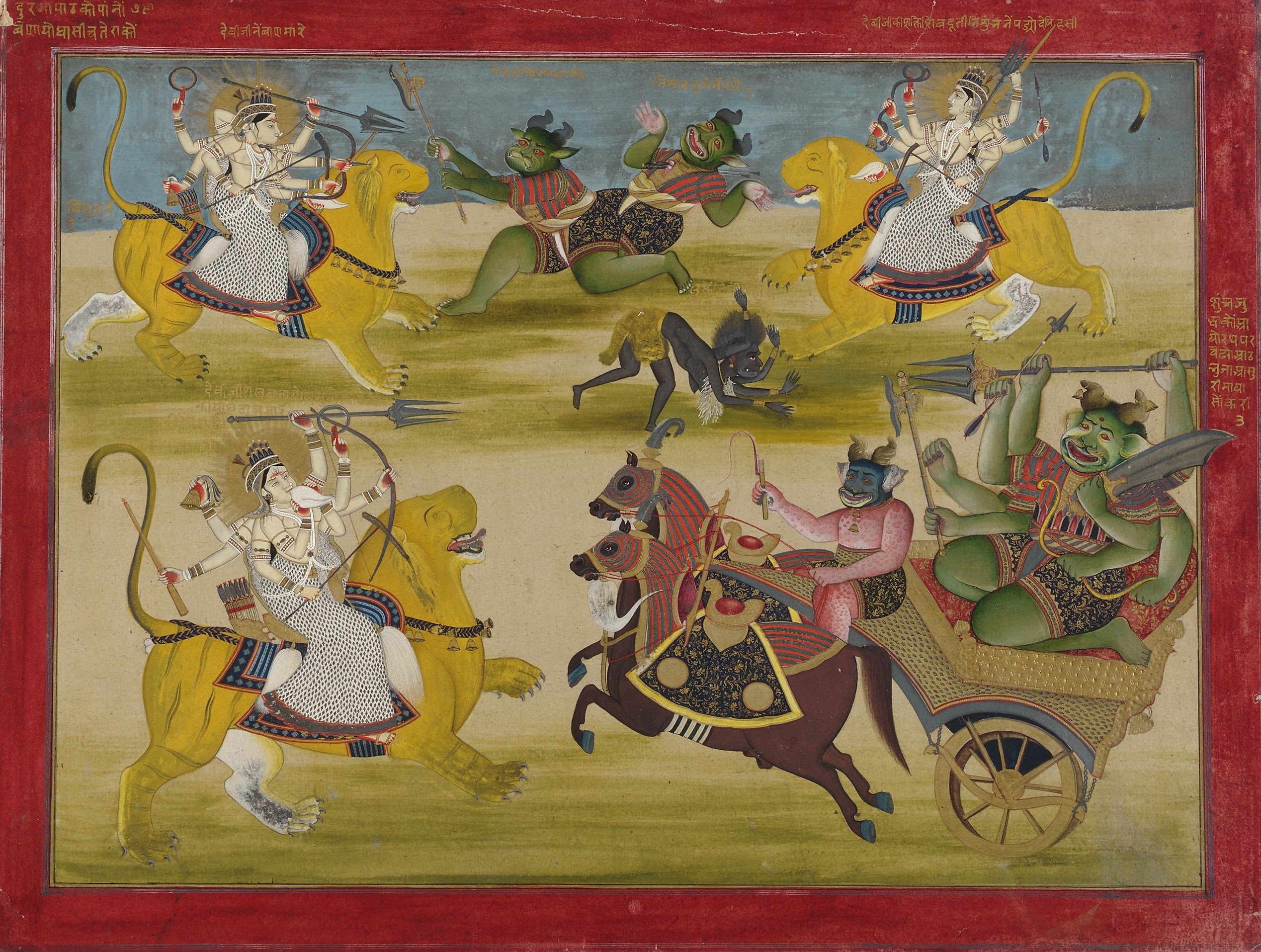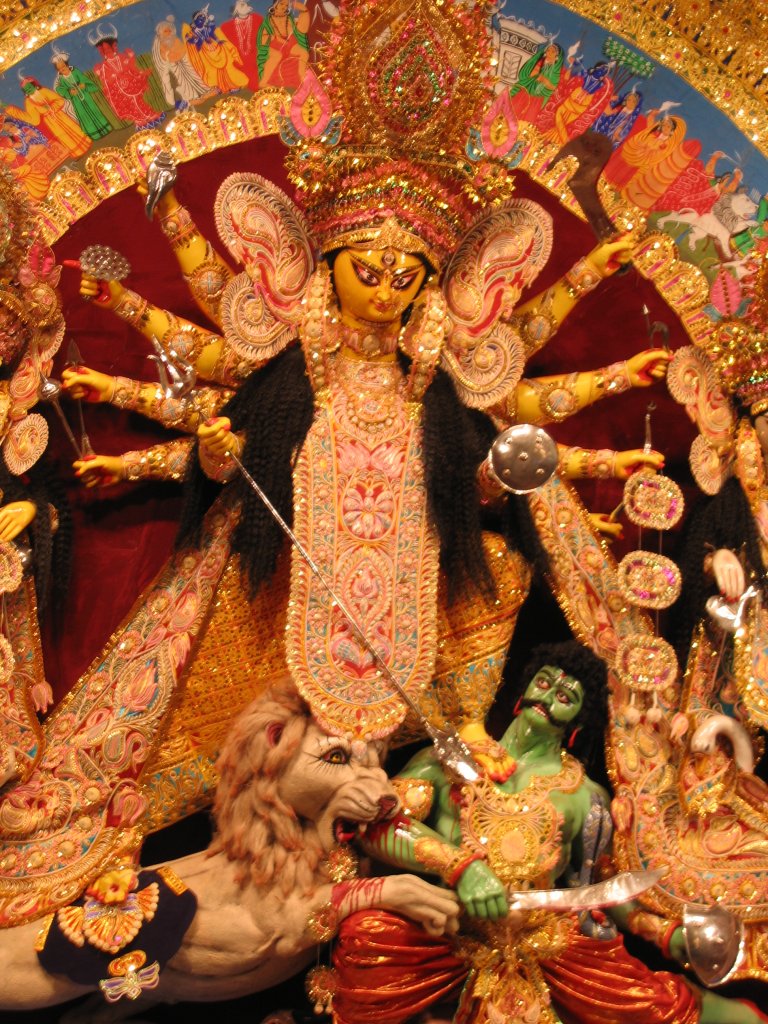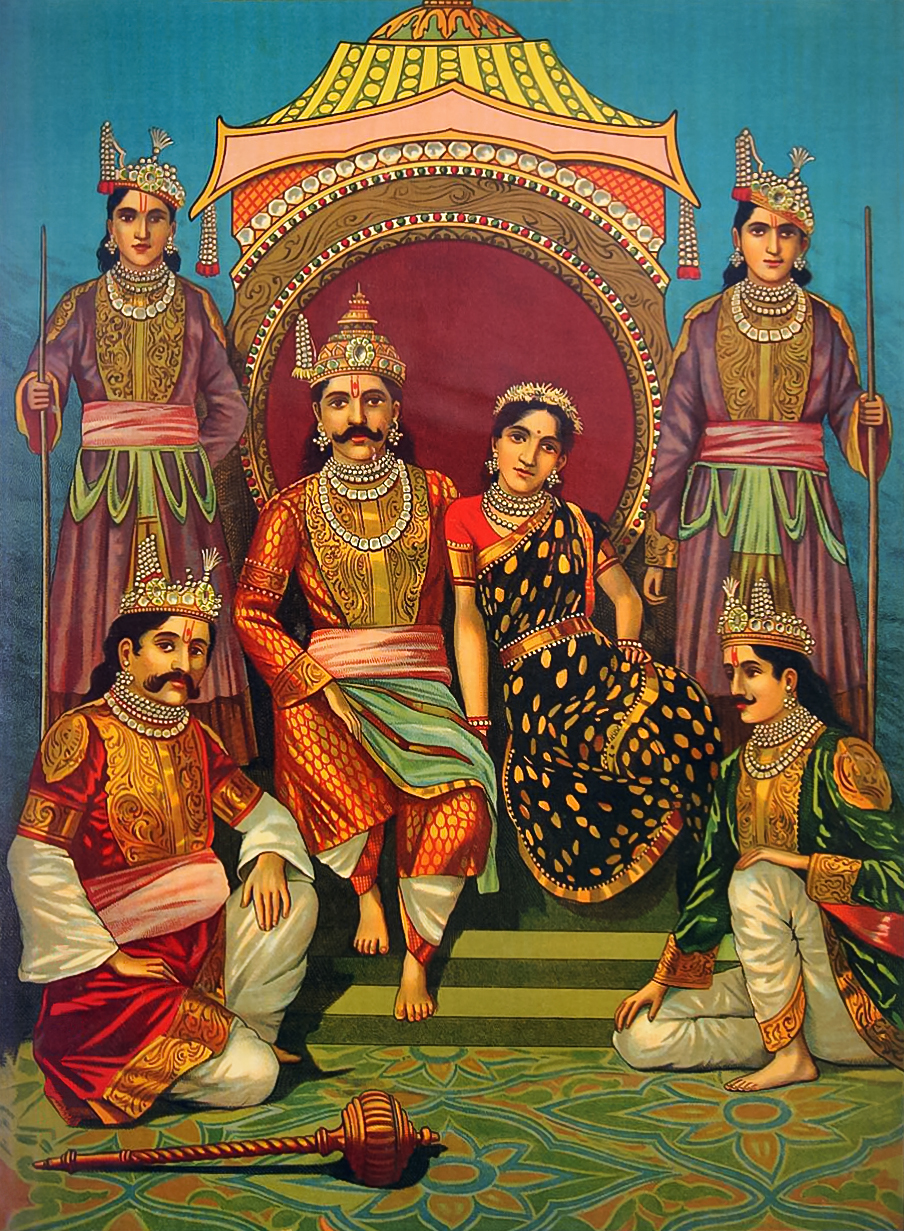|
Shumbha And Nishumbha
Shumbha (शुम्भ) and Nishumbha (निशुम्भ) are two asuras in Hindu mythology, featured in the ''Devi Mahatmya''. In their legend, they were slain by the goddess Kaushiki. Legend The story of Shumbha and Nishumbha begins in the fifth chapter of the ''Devi Mahatmya''. Durga retells how two asura brothers sought to conquer the three worlds by subjecting themselves to severe penance and purification rituals so that no man or asura could destroy them. Shumbha and Nishumbha traveled to Pushkara, a sacred site, and remained there in prayer for ten thousand years. The creator deity Brahma saw the brothers' penance, and was pleased, granting them the boon they requested. Chanda and Munda, two lesser asuras in the service of Shumbha, encountered the goddess Durga, and were overwhelmed by her beauty. They carried reports of this goddess to Shumbha, who sought to possess Durga. Shumbha sent the asura Sugriva to court Parvati, but she rejected his advances. It was the ... [...More Info...] [...Related Items...] OR: [Wikipedia] [Google] [Baidu] |
Durga Fighting The Rakshashas Shunga And Nishunga
Durga (, ) is a major Hindu goddess, worshipped as a principal aspect of the mother goddess Mahadevi. She is associated with protection, strength, motherhood, destruction, and wars. Durga's legend centres around combating evils and demonic forces that threaten peace, prosperity, and dharma, representing the power of good over evil. Durga is believed to unleash her divine wrath against the wicked for the liberation of the oppressed, and entails destruction to empower creation. Durga is seen as a motherly figure and often depicted as a beautiful woman, riding a lion or tiger, with many arms each carrying a weapon and often defeating demons. She is widely worshipped by the followers of the goddess-centric sect, Shaktism, and has importance in other denominations like Shaivism and Vaishnavism. The most important texts of Shaktism, Devi Mahatmya and Devi Bhagavata Purana, revere Devi (the Goddess) as the primordial creator of the universe and the Brahman (ultimate truth and reali ... [...More Info...] [...Related Items...] OR: [Wikipedia] [Google] [Baidu] |
Kali Attacking Nisumbha, C
Kali (; , ), also called Kalika, is a major goddess in Hinduism, primarily associated with time, death and destruction. Kali is also connected with transcendental knowledge and is the first of the ten Mahavidyas, a group of goddesses who provide liberating knowledge. Of the numerous Hindu goddesses, Kali is held as the most famous. She is the preeminent deity in the Hindu tantric and the Kalikula worship traditions, and is a central figure in the goddess-centric sects of Hinduism as well as in Shaivism. Kali is chiefly worshipped as the Divine Mother, Mother of the Universe, and Divine feminine energy. The origins of Kali can be traced to the pre-Vedic and Vedic era goddess worship traditions in the Indian subcontinent. Etymologically, the term ''Kali'' refers to one who governs time or is black. The first major appearance of Kali in the Sanskrit literature was in the sixth-century CE text ''Devi Mahatmya''. Kali appears in many stories, with the most popular one being wh ... [...More Info...] [...Related Items...] OR: [Wikipedia] [Google] [Baidu] |
Rambha (asura)
Rambha is an asura in Hindu mythology. Rambha and Karambha are asura brothers, born as the descendants of Danu and Kashyapa. When they were young, both decided to perform penance to get special powers to establish the rule of Danavas in the universe. Penance and boon According to the Puranas, Rambha and Karambha did Tapas (Indian religions) at Pañcanada for the blessing of having children. Rambha and Karambha meditated upon Mālavaṭa Yakṣa, the former seated at the centre of the five fires and the latter standing in the water of a lake. Indra found out about this, he decided to kill them, first in the guise of a crocodile dragged Karambha away by the feet and killed him by drowning him. Then Indra went after Rambha to kill him but was saved by Agni. Angry at the death of his brother, Rambha decided to cut off his head and offer it as a sacrifice. When he was about to do so, Agni appeared and told him that suicide was worse than killing others, denouncing it as a great sin ... [...More Info...] [...Related Items...] OR: [Wikipedia] [Google] [Baidu] |
Mahishasura
Mahishasura (, ) is a bovine asura in Hinduism. He is depicted in Hindu texts, Hindu literature as a deceitful demon who pursued his evil ways by shape-shifting. Mahishasura was the son of the asura Rambha (asura), Rambha and the brother of buffalo-demoness named Mahishi (demoness), Mahishi. He was ultimately killed by the goddess Durga with her trishula (trident) after which she gained the epithet Mahishasuramardini ("Slayer of Mahishasura"). Mahishasura had a son named Gajasura. The Navaratri ("Nine Nights") festival eulogises this battle between Mahishasura and Durga, culminating in Vijaya Dasami, Vijayadashami, a celebration of his ultimate defeat. This story of the "triumph of good over evil" carries profound symbolism in Hinduism, particularly Shaktism, and is both narrated as well as reenacted from the Devi Mahatmya at many South and Southeast Asian Hindu temples. The ''Mahishasura Mardini Stotra'' by Adi Shankara was written to commemorate her legend. Legend Mahis ... [...More Info...] [...Related Items...] OR: [Wikipedia] [Google] [Baidu] |
Pandavas
The Pandavas (Sanskrit: पाण्डव, aɳɖɐʋᵊ IAST: Pāṇḍava) is a group name referring to the five legendary brothers, Yudhishtira, Bhima, Arjuna, Nakula, and Sahadeva, who are central figures of the Hindu epic ''Mahabharata''. They are acknowledged as the sons of Pandu, the King of Kuru, but were fathered by different '' Devas'' (gods) due to Pandu's cursed inability to naturally sire children. In the epic, the Pandavas married Draupadi, the princess of Panchala, and founded the city of Indraprastha after the Kuru Kingdom was split to avoid succession disputes. After the split, the other part of the kingdom was ruled by their cousins, the Kauravas. However, the Pandavas lost their kingdom to Duryodhana (eldest and king of the Kauravas) when Yudhishthira gambled it away during a game of dice. The bet Yudhishtira agreed to was that the Pandavas would hand the kingdom over to the Kauravas and go into exile for 12 followed by an year in hiding. After this ... [...More Info...] [...Related Items...] OR: [Wikipedia] [Google] [Baidu] |
The Great Indian Novel
''The Great Indian Novel'' is a satirical novel by Shashi Tharoor, first published by Viking Press in 1989. It is a fictional work that takes the story of the ''Mahabharata'', the Indian epic, and recasts and resets it in the context of the Indian independence movement and the first three decades post-independence. Figures from Indian history are transformed into characters from mythology, and the mythical story of India is retold as a history of Indian independence and subsequent history, up through the 1970s. Some critics have identified an element of subversion in the novel. The work includes numerous puns and allusions to famous works about India, such as those by Rudyard Kipling, Paul Scott, and E. M. Forster. The ''Mahabharata'' is an epic tale describing the historical dynastic struggle over the throne of the kingdom of Hastinapur between the Pandavas and the Kauravas, two branches of the heirs of the King Shantanu. In his novel, Tharoor recasts the story of the nas ... [...More Info...] [...Related Items...] OR: [Wikipedia] [Google] [Baidu] |
Satirical
Satire is a genre of the visual arts, visual, literature, literary, and performing arts, usually in the form of fiction and less frequently Nonfiction, non-fiction, in which vices, follies, abuses, and shortcomings are held up to ridicule, often with the intent of exposing or shaming the perceived flaws of individuals, corporations, government, or society itself into improvement. Although satire is usually meant to be humorous, its greater purpose is often constructive social criticism, using wit to draw attention to both particular and wider issues in society. Satire may also poke fun at popular themes in art and film. A prominent feature of satire is strong irony or sarcasm—"in satire, irony is wikt:militant, militant", according to Literary criticism, literary critic Northrop Frye— but parody, burlesque (literary), burlesque, exaggeration, juxtaposition, comparison, analogy, and double entendre are all frequently used in satirical speech and writing. This "militant" ... [...More Info...] [...Related Items...] OR: [Wikipedia] [Google] [Baidu] |
Shashi Tharoor
Shashi Tharoor (; born 9 March 1956) is an Indian politician, author, and former diplomat, who has been serving as Member of Parliament for Thiruvananthapuram, Kerala, since 2009. He is currently the Chairman of Committee on External Affairs. He was formerly an Under-Secretary-General of the United Nations and 2006 United Nations Secretary-General selection for the post of Secretary-General in 2006. Founder-Chairman of All India Professionals Congress, he formerly served as Chairman of the Parliamentary Standing Committee on External Affairs and on Informational Technology. He has about two dozen titles to his credit and was awarded by World Economic Forum as "Global Leader of Tomorrow". Born in London and raised in Mumbai and Kolkata, Tharoor graduated from St. Stephen's College, Delhi, in 1975 and culminated his studies in 1978 with a doctorate in International Relations and Affairs from the Fletcher School of Law and Diplomacy, Tufts University. At the age of 22, he was ... [...More Info...] [...Related Items...] OR: [Wikipedia] [Google] [Baidu] |
Trishula
The ''trishula'' () is a trident, a divine symbol, commonly used as one of the principal symbols in Hinduism. It is most commonly associated with the deity Shiva and widely employed in his iconography. Etymology The name ''trishula'' ultimately derives from the Sanskrit word त्रिशूल (triśūla), from त्रि (trí), meaning "three", and शूल (śū́la), meaning "a sharp iron pin or stake", referring in this case to the weapon's three prongs. Symbolism The ''trishula'' has a number of interpretations in Hindu belief. The three points of the weapon have various meanings and significance have many stories behind them. They are commonly said to represent various trinities: creation, preservation, and destruction; past, present, and future; body, mind and atman; Dharma (law and order), bliss/mutual enjoyment and emanation/created bodies; compassion, joy and love; spiritual, psychic and relative; happiness, comfort and boredom; pride, repute and egotism ... [...More Info...] [...Related Items...] OR: [Wikipedia] [Google] [Baidu] |
Parvati
Parvati (, , IPA: /Sanskrit phonology, pɑɾʋət̪iː/), also known as Uma (, , IPA: Sanskrit phonology, /ʊmɑː/) and Gauri (, , IPA: /Sanskrit phonology, gə͡ʊɾiː/), is one of the principal goddesses in Hinduism, revered as the Devi, goddess of power, energy, nourishment, harmony, love, beauty, devotion, and motherhood. Along with Lakshmi and Saraswati, Sarasvati, she forms the trinity, known as the Tridevi. From her first appearance as a goddess during the Itihasa-Purana, epic period (400 BCE – 400 CE), Parvati is primarily depicted as the consort of the god Shiva. According to various Puranas, Parvati is the reincarnation of Sati (Hindu goddess), Sati, Shiva's first wife, who relinquished her body to sever familial ties with her father, Daksha, after he had insulted Shiva. Parvati is often equated with the other goddesses such as Sati, Uma, Kali and Durga and due to this close connection, they are often treated as one and the same, with their stories frequently ove ... [...More Info...] [...Related Items...] OR: [Wikipedia] [Google] [Baidu] |
Kali
Kali (; , ), also called Kalika, is a major goddess in Hinduism, primarily associated with time, death and destruction. Kali is also connected with transcendental knowledge and is the first of the ten Mahavidyas, a group of goddesses who provide liberating knowledge. Of the numerous Hindu goddesses, Kali is held as the most famous. She is the preeminent deity in the Hindu tantric and the Kalikula worship traditions, and is a central figure in the goddess-centric sects of Hinduism as well as in Shaivism. Kali is chiefly worshipped as the Divine Mother, Mother of the Universe, and Divine feminine energy. The origins of Kali can be traced to the pre-Vedic and Vedic era goddess worship traditions in the Indian subcontinent. Etymologically, the term ''Kali'' refers to one who governs time or is black. The first major appearance of Kali in the Sanskrit literature was in the sixth-century CE text '' Devi Mahatmya''. Kali appears in many stories, with the most popular one bein ... [...More Info...] [...Related Items...] OR: [Wikipedia] [Google] [Baidu] |








